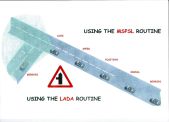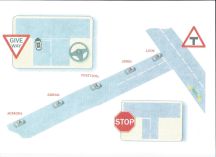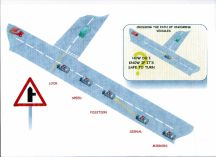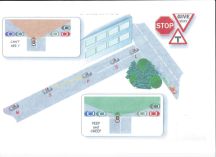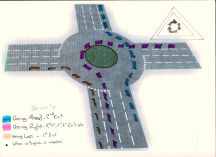Written lessons
Approaching junctions - Left
Apply the MSPSL routine
- M = mirrors, check your CENTER mirror then your LEFT mirror, then look FORWARDS
- S = signal left using the LEFT indicator (usually on left stalk under steering wheel but can be on the right)
- P = Position the vehicle in the Normal Driving Position (unless on a narrow road).
- S = speed should be Slowed down to what is needed for the turn, select a lower gear like 2nd or 1st depending on how tight the corner/road is.
- L = Look at approaching traffic, is anyone coming? then look into the road you are going into for 1) park cars either side of the road, 2) pedestrians crossing the road.
When turning, make sure your clutch pedal is up or very close to being up. This will give a more controlled feel to the turn. This doesn't apply to auto!
Priorities
You have priority over pretty much all other vehicles except emergency vehicles. You are on a MAIN road turning into a MINOR road, this is identified by the absence of GIVE WAY lines before you enter the junction on the left.
becomeadriver@yahoo.co.uk 07917276796
Emerging t Junctions - LEFT
Apply the MSPSL routine
- M = mirrors, check your CENTER mirror then your LEFT mirror, then look FORWARDS
- S = signal ;eft using the LEFT indicator (usually on left stalk under steering wheel but can be on the right)
- P = Position the vehicle Normal Driving Position (unless on a narrow road).
- S = speed should be Slowed down to what is needed for the turn, select a lower gear like 2nd or 1st depending on how tight the corner/road is or if you have to stop/give way.
- L = Look at Crossing traffic, are opportunities coming? Look RIGHT LEFT RIGHT as a minimum, then look into the road you are going into for 1) park cars either side of the road, 2) pedestrians crossing the road.
- Judgement = you can take an opportunity to go if you answer no to the 3 s's , STOP SWERVE SLOW DOWN
When turning, make sure your clutch pedal is up or very close to being up. This will give a more controlled feel to the turn. This doesn't apply to auto
Turning points
- Hold back position = Double dotted line at the end of the road is just under your right door mirror (turn s/wheel 1/2 left)
- Turning point = Follow curb round and straighten up when you are straight. (Turn later if obstructions about on your side)
Priorities
You must wait for a clear opportunity on the MAIN road before going.
Approaching junctions - RIGHT
Apply the MSPSL routine
- M = mirrors, check your CENTER mirror then your RIGHT mirror, then look FORWARDS
- S = signal right using the RIGHT indicator (usually on left stalk under steering wheel but can be on the right)
- P = Position the vehicle in the Just Left of the Centre line (unless on a narrow road).
- S = speed should be Slowed down to what is needed for the turn, select a lower gear like 2nd or 1st depending on how tight the corner/road is.
- L = Look at approaching traffic, is anyone coming? then look into the road you are going into for 1) park cars either side of the road, 2) pedestrians crossing the road.
- Judgement = you can take an opportunity to go if you answer no to the 3 s's , STOP SWERVE SLOW DOWN
When turning, make sure your clutch pedal is up or very close to being up. This will give a more controlled feel to the turn
Turning points
- Hold back position = centre line of road turning into is just at the top of your right door mirror
- Turning point = centre line of road turning into is just underneath your right door mirror.
Priorities
You have priority over the minor roads, but not the traffic approaching you. Wait for the opportunity to go ( 3 S's)
Emerging t Junctions - RIGHT
Apply the MSPSL routine
- M = mirrors, check your CENTER mirror then your RIGHT mirror, then look FORWARDS
- S = signal right using the RIGHT indicator (usually on left stalk under steering wheel but can be on the right)
- P = Position the vehicle Just Left of the Centre line (unless on a narrow road).
- S = speed should be Slowed down to what is needed for the turn, select a lower gear like 2nd or 1st depending on how tight the corner/road is.
- L = Look at Crossing traffic, are opportunities coming? Look RIGHT LEFT RIGHT as a minimum, then look into the road you are going into for 1) park cars either side of the road, 2) pedestrians crossing the road.
- Judgement = you can take an opportunity to go if you answer no to the 3 s's , STOP SWERVE SLOW DOWN
When turning, make sure your clutch pedal is up or very close to being up. This will give a more controlled feel to the turn
Turning points
- Hold back position = single dotted line at the end of the road is just under your right door mirror (keep s/wheel straight)
- Turning point = single dotted line is just in line with your shoulder. (Turn earlier if obstructions about)
Priorities
You must wait for a clear opportunity on the MAIN road before going.
Round-a-bouts
General round-a-bouts -
Turning Left - MSPSL on approach, keep in left hand lane or Normal Driving Position (NDP)
Turning right - MSPSL on approach, keep in right hand lane or just left of centre line.
Straight ahead (usually 2nd exit) - keep to the left hand lane when no road markings.
Positioning -
Turn left = NDP or left hand lane - please note road markings may suggest alternative
Turn right = Just left of centre line or right hand lane - please note road markings may suggest alternative
Straight ahead = Left hand lane, middle lane or right hand lane depending on what road markings or signs there are. But generally left hand lane.
Priorities -
Give way to traffic already on roundabout to the right
Look on approach if roundabout seems light with traffic and select a gear
(usually 2nd) to keep going if it is safe or stop if you can’t go.
Use traffic or larger vehicles for cover that may stop traffic coming from right leaving a safe gap to go.
THINK OF THE 3 S's (will I make the vehicles stop swerve or slow down)
for when it is time to go, if answer is yes DON'T GO.
Exiting roundabout - Signal left at the junction before your intended exit;
- straight ahead - keep in left lane signal left as you pass 1st exit
- turning right - M S left then drift/steer over to the left before the junction you want to exit (i e; 2nd exit if taking 3rd exit)
- If you're exiting on a dual carriage way, always try to exit in the left hand lane if it is safe to do so, unless turning right soon after or overtaking a slower vehicle
Mini roundabouts -
Give way to the right
Signal left/right if turning on the approach
No signals to exit as it affects your steering too much
If everyone stops, you go as it breaks the cycle of everyone giving way to the right!
General approach and use of roundabouts
In short - signal left or right on the approach to roundabouts if going left or right (don't signal going straight ahead)
Get in to position for where you're going
Look to the right and ahead (left as you move away)
Keep in lane...
Signal left to exit when on the roundabout for 2nd exit and on....drift to the exit when checked it's safe
Keep a steady speed without hesitation (keep check of the traffic and adjust accordingly)

